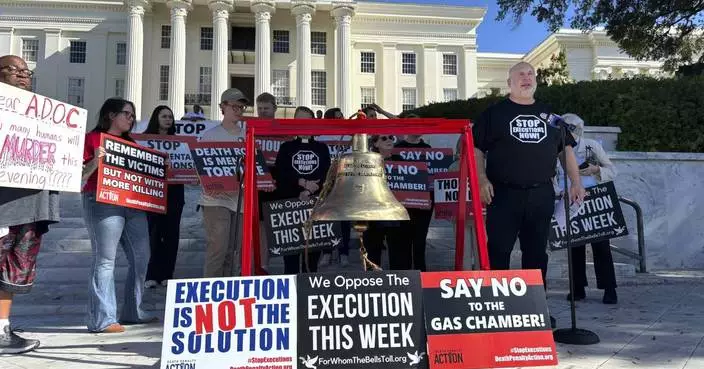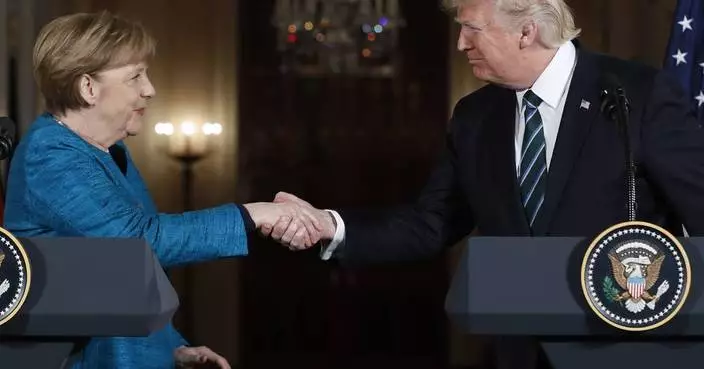On Football analyzes the biggest topics in the NFL from week to week. For more On Football analysis, head here.
Joe Douglas is gone. Robert Saleh already was fired. Aaron Rodgers could be next to leave the New York Jets.
Douglas lost his job as the general manager on Tuesday, six weeks after the head coach was replaced following a 2-3 start. The Jets have gone 1-5 under interim coach Jeff Ulbrich so owner Woody Johnson sent Douglas packing.
Rodgers has played more like a 40-year-old quarterback coming off an Achilles tendon injury than a four-time NFL MVP. He’s expressed a desire to play another season. The big question is whether the Jets will want him back. Maybe they’ll decide to take one more shot at a playoff run with Rodgers while having him mentor a rookie quarterback. Or, they could start fresh. There are significant contract ramifications either way.
Rodgers is slated to make a non-guaranteed $37.5 million in 2025 with a dead cap hit of $49 million as his salary cap total goes from $17.1 million to $23.5 million.
The Jets could spread the dead money over two years by releasing Rodgers with the use of post-June 1 designation. He has a no-trade clause in his contract so they would need his permission to make a deal.
If Rodgers doesn’t retire and New York’s new regime wants a clean slate, here are potential destinations for the future first-ballot Hall of Famer:
SAN FRANCISCO 49ERS: This could only happen if Brock Purdy’s shoulder injury is more significant than is known. Rodgers is a native of northern California and grew up a Niners fan. Returning home to help San Francisco win its sixth Super Bowl has to be attractive. Playing for coach Kyle Shanahan surrounded by playmakers Christian McCaffrey, Deebo Samuel and George Kittle would be a quarterback’s dream. Again, Purdy is the team’s present and future. And, he’s resilient. Purdy rebounded from elbow surgery following his rookie season to start Week 1 last year and ended up finishing fourth in MVP voting, leading the 49ers to the Super Bowl. Purdy also is due for a contract extension and a major raise so the salary cap makes this even more of a longshot. But never say never in the NFL.
MINNESOTA VIKINGS: Sam Darnold has been more than a stopgap, helping the Vikings (8-2) to an impressive start. J.J. McCarthy is the future, however, and Darnold will be a free agent after the season. If the Vikings fall short of a Super Bowl and Rodgers shows over the final six weeks that he can play championship football, this could be a fit. The Vikings could let McCarthy sit and learn for another year, especially coming off a knee injury that required a second surgery earlier this month.
NEW YORK GIANTS: Rodgers wouldn’t have to move. The Giants will need a quarterback after benching Daniel Jones this week with the intent to move on from him. They could draft a quarterback in the first round and have him learn behind Rodgers for a season. That’ll depend on which pick New York ends up with because it’s a thin draft class. Unlike the Jets, the Giants (2-8) haven’t made any coaching or GM changes yet. If it’s status quo with GM Joe Schoen and coach Brian Daboll, one year with Rodgers isn’t unrealistic.
LAS VEGAS RAIDERS: They also need a quarterback. Brock Bowers could set an NFL record for most catches by a tight end if he had Rodgers next season. The Raiders (2-8) are aiming for a high pick to get a shot at a quarterback of their choice. New minority owner Tom Brady believes rookie quarterbacks need time to develop and learn. The seven-time Super Bowl champion would have to be in favor of having Rodgers start and tutor a youngster.
TENNESSEE TITANS: If Will Levis doesn’t prove over the final seven games that he can be a No. 1 quarterback, the Titans (2-8) will be in the QB market and likely have a high draft pick. It’s another scenario where Rodgers would fit as a one-year bridge.
AP NFL: https://apnews.com/hub/nfl

New York Jets quarterback Aaron Rodgers (8) reacts during the fourth quarter of an NFL football game against the Indianapolis Colts, Sunday, Nov. 17, 2024, in East Rutherford, N.J. (AP Photo/Adam Hunger)

New York Jets quarterback Aaron Rodgers (8) passes against the Indianapolis Colts during the first quarter of an NFL football game, Sunday, Nov. 17, 2024, in East Rutherford, N.J. (AP Photo/Adam Hunger)
NEW YORK (AP) — Bitcoin extended its streak of record highs Friday adding to its explosive growth since the U.S. presidential election. The cryptocurrency has rocketed more than 40% in just two weeks.
Now, bitcoin is at the doorstep of $100,000, just two years after dropping below $17,000 following the collapse of crypto exchange FTX. The dramatic rally arrives as industry players expect the incoming Trump administration to bring a more “crypto-friendly” approach toward regulating the digital currency.
Bitcoin traded at $98,349 early Friday, according to FactSet, a new high.
As with everything in the volatile cryptoverse, the future is impossible to know. And while some are bullish, other experts continue to warn of investment risks.
Here’s what you need to know.
Cryptocurrency has been around for a while now. But, chances are, you've heard about it more and more over the last few years.
In basic terms, cryptocurrency is digital money. This kind of currency is designed to work through an online network without a central authority — meaning it’s typically not backed by any government or banking institution — and transactions get recorded with technology called a blockchain.
Bitcoin is the largest and oldest cryptocurrency, although other assets like ethereum, tether and dogecoin have also gained popularity over the years. Some investors see cryptocurrency as a “digital alternative” to traditional money — but it can be very volatile, with its price reliant on larger market conditions.
A lot of the recent action has to do with the outcome of the U.S. presidential election.
Crypto industry players have welcomed Trump’s victory, in hopes that he would be able to push through legislative and regulatory changes that they’ve long lobbied for — which, generally speaking, aim for an increased sense of legitimacy without too much red tape.
Trump, who was once a crypto skeptic, recently pledged to make the U.S. “the crypto capital of the planet” and create a “strategic reserve” of bitcoin. His campaign accepted donations in cryptocurrency and he courted fans at a bitcoin conference in July. He also launched World Liberty Financial, a new venture with family members to trade cryptocurrencies.
How of this will actually pan out — and whether or not Trump will successfully act quickly on these promises — has yet to be seen.
“This is not necessarily a short-term story, it’s likely a much longer-term story," Citi macro strategist David Glass told The Associated Press last week. "And there is the question of how quickly can U.S. crypto policy make a serious impact on (wider adoption).”
Adam Morgan McCarthy, a research analyst at Kaiko, thinks the industry is craving “just some sort of clarity.” Much of the approach to regulating crypto in the past has been “enforcement based,” he notes, which has been helpful in weeding out some bad actors — but legislation might fill in other key gaps.
Gary Gensler, who as head of the Securities and Exchange Commission under President Joe Biden has led a U.S. government’s crackdown on the crypto industry, penalized a number of crypto companies for violating securities laws. Gensler announced Thursday that he would step down as SEC chair on Jan. 20, Inauguration Day.
Despite crypto’s recent excitement around Trump, McCarthy said that 2024 has already been a “hugely consequential year for regulation in the U.S.” — pointing to January’s approval of spot bitcoin ETFs, for example, which mark a new way to invest in the asset.
Spot ETFs have been the dominant driver of bitcoin for some time now — but, like much of the crypto’s recent momentum, saw record inflows postelection. According to Kaiko, bitcoin ETFs recorded $6 billion in trade volume for the week of the election alone.
In April, bitcoin also saw its fourth “halving” — a preprogrammed event that impacts production by cutting the reward for mining, or the creation of new bitcoin, in half. In theory, if demand remains strong, some analysts say this “supply shock” can also help propel the price long term. Others note it may be too early to tell.
History shows you can lose money in crypto as quickly as you’ve made it. Long-term price behavior relies on larger market conditions. Trading continues at all hours, every day.
At the start of the COVID-19 pandemic, bitcoin stood at just over $5,000. Its price climbed to nearly $69,000 by November 2021, during high demand for technology assets, but later crashed during an aggressive series of Federal Reserve rate hikes. And in late 2022 collapse of FTX significantly undermined confidence in crypto overall, with bitcoin falling below $17,000.
Investors began returning in large numbers as inflation started to cool — and gains skyrocketed on the anticipation and then early success of spot ETFs. But experts still stress caution, especially for small-pocketed investors. And lighter regulation from the coming Trump administration could mean less guardrails.
While its been a big month for crypto — and particularly bitcoin, which McCarthy notes has set record highs for ten of the last 21 days — there's always risk for “correction," or seeing prices fluctuate back down some. Some assets may also have more restrictions than others.
“I would say, keep it simple. And don’t take on more risk than you can afford to," McCarthy said — adding that there isn't a “magic eight ball” to know for certain what comes next.
Assets like bitcoin are produced through a process called “mining,” which consumes a lot of energy. Operations relying on pollutive sources have drawn particular concern over the years.
Recent research published by the United Nations University and Earth’s Future journal found that the carbon footprint of 2020-2021 bitcoin mining across 76 nations was equivalent to the emissions from burning 84 billion pounds of coal or running 190 natural gas-fired power plants. Coal satisfied the bulk of bitcoin’s electricity demands (45%), followed by natural gas (21%) and hydropower (16%).
Environmental impacts of bitcoin mining boil largely down to the energy source used. Industry analysts have maintained that clean energy has increased in use in recent years, coinciding with rising calls for climate protections

An employee watches an electronic signboard displaying the prices of Bitcoin and other cryptocurrencies at the lounge of Bithumb cryptocurrency exchange in Seoul, South Korea, Thursday, Nov. 21, 2024. (AP Photo/Ahn Young-joon)












